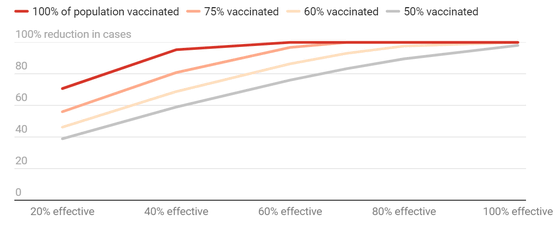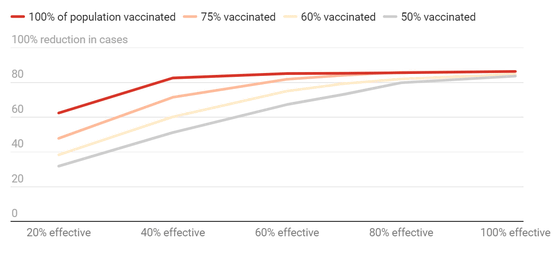What level of 'efficacy' vaccine is needed for the convergence of the new coronavirus pandemic?

With respect to the new coronavirus infectious disease (COVID-19), which continues to spread worldwide, pharmaceutical companies and research institutions around the world are rushing to develop a 'vaccine' to stop the infection. However, even if a vaccine is developed, whether the vaccine will reduce the pandemic of COVID-19 depends on 'effectiveness of the vaccine,' said Bruce Y. Lee, a professor of public health at the City University of New York. I am explaining.
Vaccine Efficacy Needed for a COVID-19 Coronavirus Vaccine to Prevent or Stop an Epidemic as the Sole Intervention-American Journal of Preventive Medicine
How effective does a COVID-19 coronavirus vaccine need to be to stop the pandemic? A new study has answers
https://theconversation.com/how-effective-does-a-covid-19-coronavirus-vaccine-need-to-be-to-stop-the-pandemic-a-new-study-has-answers-142468
The measles vaccine has an onset-preventive effect of 85% for the first dose and 95% for the second dose, so it is not possible to obtain a '100% preventive effect'. In the case of influenza vaccine , the preventive effect is 25 to 60% in children and 50 to 60% in adults, and it cannot be said that 'it will not be infected even if inoculated'.
As these numbers show, in order to really control the epidemic of infectious diseases, it is important not only to develop a vaccine, but also to be “effectiveness of the developed vaccine”. Professor Lee explained the effectiveness of the vaccine by citing two words, 'efficacy' and 'effectiveness.'
When translated into Japanese, 'efficacy' and 'effectiveness' both mean 'effectiveness,' but they mean different concepts in pharmacoepidemiology. In order to bring out the effect as purely as possible, the new drug is usually administered to patients with complications and comorbidities, as well as subjects excluding elderly people and children with poor liver/kidney capacity, and the results are measured. And the effectiveness of the vaccine in this prepared and ideal environment is described as 'efficacy'. On the other hand, 'effectiveness' refers to the effectiveness of the vaccine in the real environment.
It is reported that ' mRNA-1273 ' developed by American biotechnology company Moderna and ' ChAdOx1 nCoV-19 ' developed by Oxford University are 'immunity acquisition rate against COVID-19 100%', but this is only a test It is a result in the environment and is classified as 'efficacy'. Normally, the effectiveness of the actual environment tends to be lower than the effectiveness of the test environment, so even if the immunity acquisition rate is 100% in the test environment, how effective the developed vaccine is in the real environment Professor Lee argues that it is not possible to know whether to show it without actually using it.
Oxford University develops a vaccine that produces antibodies against coronavirus, with 100% immunity and no serious side effects-GIGAZINE

A research team at the School of Public Health, City of New York, led by Professor Lee, collaborated with a research team at Baylor College of Medicine to create a program that simulates the epidemic of COVID-19 across the United States. We entered various possible scenarios as initial conditions and conducted a simulation of 'how the situation of epidemics will change if vaccines are distributed.'
The epidemic situation when a vaccine is distributed changes according to the 'effectiveness' and 'inoculation rate' of the vaccine. The following is a graph in the scenario of '0% of the total population is infected' in the early pandemic, and each graph is divided according to the vaccination rate. The horizontal axis shows the effectiveness of the vaccine and the vertical axis shows the reduction rate of COVID-19 epidemics.

To suppress the epidemic in the early pandemic, a vaccination rate of 100% requires 60% effectiveness, a vaccination rate of 75% requires 70% effectiveness, and a vaccination rate of 60% requires 80% effectiveness. '100% coverage will not be possible,' said Lee, citing people who could not vaccinate due to age or health problems and
In addition, the graph of the scenario '5% of the total population is infected' is below. In the United States, approximately 1% of the total population has been confirmed to be infected, but health officials estimate that the actual percentage is much higher than 1%. In this scenario, the maximum epidemic reduction rate will only reach 85%.

Based on these simulation results, Lee said, 'If the vaccine has an efficacy of 60%, the vaccination rate must reach 100%. However, 'Do you inoculate a new vaccine that has been confirmed to be safe? Approximately 75% of Americans responded to the questionnaire 'I am inoculated', so a vaccine with an efficacy of 60% cannot return society to normal. It is necessary.' Even if the vaccine is completed, depending on the effectiveness of the vaccine, it is impossible to return to the 'pre-corona' era, and we have to continue the 'post-corona' life by wearing a mask and maintaining social distance. Insisted.
Related Posts:
in Science, Posted by darkhorse_log







